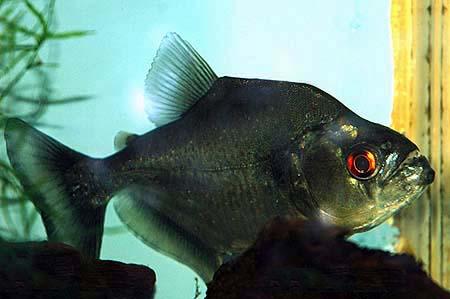Pirahna black
Scientific Name: Serrasalmus niger
Sat, 19th July, 2025 - 3:22 am GMT
Sponsor Ads:

Alternative Name
Scientific Name: Serrasalmus nigerBasic Info
At maturity, Black Piranhas can reach a size of two feet in the wild, though they are usually much smaller in captivity. The maximum documented captive length is a 16-inch individual that was housed in a 400-gallon tank. They have flat and round shaped bodies. Their bodies have a yellow brown to black tint, with golden reflective scales. Their dorsal fin is far back on the body, and is gray, while the caudal fin is small, relative to other Piranhas, and is also gray. Black Piranhas, however, are best known for their razor sharp triangular teeth, which do great when ripping through flesh.
Health
The Black Piranha is a hardy fish. It can withstand pH levels from 5.8 to 7.5, but a slightly acidic to neutral pH is best. The water they live in should have a temperature between 72 and 77 degrees fahrenheit. Being one of, if not the most ferrocious fish available, great care must be taken when handling the Black Piranha. It will not hesitate to snap on your finger, if given the chance. Foods must be all meat, including fish and pieces of meat. Their favorite food is probably feeder goldfish. They can be raised from a young age to eat meat pellets. Breeding There is currently no special breeding information in our databases for this animal. To submit breeding / propagation information that is specific to this animal please click here.Habitat
Fresh water fishBehavior
The Black Piranha is one of the most widely known fish in the world. It is known to be fearsome and aggressive, with razor sharp teeth. They make interesting pets, however, and they will keep any experienced aquarists entertained for hours. Black Piranhas are extremely aggressive. If a tank-mate is sought, a few casualties should be expected. Black Piranhas can easily kill even the most aggressive Cichlid. Plecos are probably the best possible tank-mate for the Black Piranha, but it has been reported that the Black Piranha will attack and kill a Pleco as well. It might be best to keep them as the only specieis in the tank. If several Black Piranhas are kept together, but if there is not enough space or food, they will most likely turn on each other. Also, care should be taken when feeding the Black Piranha, as it has been known to bite on fingers and hands. Black Piranhas should be kept in large tanks with plenty of swimming space. There should be plenty of large rocks, and floating plants as well. Some bogwood should be included if possible. Black Piranhas feed by ambushing their prey. In the wild they are schooling fish, but in captivity they are generally solitary fish.Origin
South AmericaHistory
The Black Piranha, or Serrasalmus Niger, is found in the Amazon Basin in South America. They are rarely available in pet stores, but most will be able to special order them, if asked.Common Foods
Diet: Naturally Herbivore, eats plants (will eat smallfish or shrimp)Sponsor Ads:
When the complexity of the problems humans must solve exceeds the capability of our brains, we turn to beliefs. -- Rebecca Costa
Pirahna black
Coded by: BGID® | ALL RIGHTS RESERVED Copyright © 2000-2025
Disclaimer | Privacy | Report Errors / Contact | Credits








 President of the United States of America - Real Estate mogul, Pageant owner and now one of the most controversial men in political history.
President of the United States of America - Real Estate mogul, Pageant owner and now one of the most controversial men in political history.  Global warming has been in and out as the "latest" hot topic for many years. It is, according to modern scientists, the result of man-made industrial pollutants, clearing forested areas, agriculture, etc. But now they are thinking it started way before the Industrial Revolution...
Global warming has been in and out as the "latest" hot topic for many years. It is, according to modern scientists, the result of man-made industrial pollutants, clearing forested areas, agriculture, etc. But now they are thinking it started way before the Industrial Revolution...  Politician, US Vice President and President of the USA - Joseph Robinette Biden Jr.
Politician, US Vice President and President of the USA - Joseph Robinette Biden Jr.  versus
versus  Russia: 'The Evil Empire'? Are they all that bad or is it just the USA trying to portray Russia as bad because they are a world power with land bigger and a society very different from the USA ideal?
Russia: 'The Evil Empire'? Are they all that bad or is it just the USA trying to portray Russia as bad because they are a world power with land bigger and a society very different from the USA ideal? 
 Corona virus
Corona virus 
 Users with wide screen monitors can benefit from more content on every page.
Users with wide screen monitors can benefit from more content on every page.